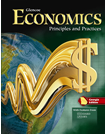Economics Principles and Practices © 2012 GeorgiaChapter 5:
SupplyChapter OverviewsSection 1: What Is Supply?
Supply, like demand, is another important microeconomic concept. Together, supply and demand explain how prices are determined and how markets function. Supply is defined as the quantities of output that producers will bring to market at each and every price. Like demand, supply can be presented in the form of a supply schedule, or graphically as a supply curve. Individual producers have their own supply curves, and the market supply curve is the sum of individual supply curves. The Law of Supply states that more output will be offered for sale at higher prices and less at lower prices. A change in quantity supplied is represented by a movement along the supply curve, whereas a change in supply is represented by a shift of the supply curve to the left or right. Changes in supply are caused by changes in the cost of inputs, productivity, technology, taxes, subsidies, expectations, government regulations, and the number of sellers in the market. Supply elasticity describes how producers will change the quantity they supply in response to a change in price. Section 2: The Theory of Production
The theory of production deals with the way output changes in the short run when a single productive input is varied. This relationship is presented graphically in the form of a production function. The two most important measures of output are total product and marginal product. Three stages of production—increasing returns, diminishing returns, and negative returns—show how marginal product changes as additional variable inputs are added. Section 3: Cost, Revenue, and Profit Maximization
Cost and revenue are added to the theory of production. Several important measures of cost are introduced, including fixed cost, variable cost, total cost, and marginal cost. Total revenue and marginal revenue are the most important measures of revenue. The firm reaches the break-even point when the revenue from sales is large enough to cover the total cost of production. Furthermore, the firm finds its profit-maximizing quantity of output where the marginal cost of production is exactly equal to marginal revenue from the sale of the product.  | 






